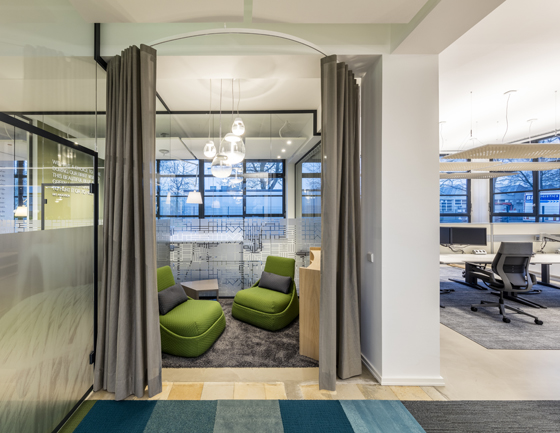Down to earth: Interface
Historia de la marca de Katharina Sommer
Krefeld, Alemania
26.09.17
Synonymous with sustainability, the floor manufacturer INTERFACE has established its new German headquarters and showroom according to the principles of Biophilic Design.
In the former gatehouse, located at the entrance of the Mies van der Rohe Business Park in Krefeld, Interface has established its new German headquarters. Photo: Bernadette Grimmenstein
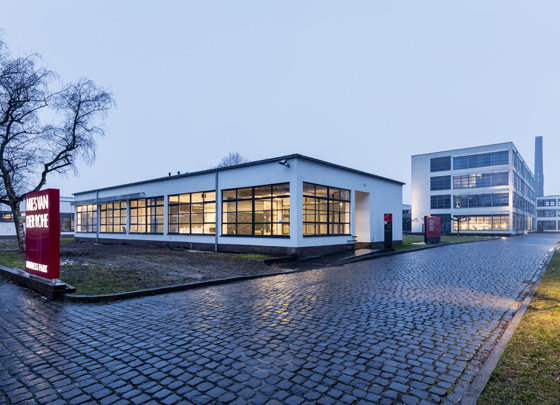
In the former gatehouse, located at the entrance of the Mies van der Rohe Business Park in Krefeld, Interface has established its new German headquarters. Photo: Bernadette Grimmenstein
×The grounds of the former silk-weaving company Vereinigte Seidenwebereien in Krefeld rank among Germany’s important industrial monuments. With its redesign as the Mies van der Rohe Business Park, the notable architectural ensemble takes on a new use which will ensure its continued existence. Last autumn, Interface, the manufacturer of modular textile floor coverings, moved into the former gatehouse there and set up its new German headquarters. In the conversion of this protected historic landmark, special attention was paid to the integration of biophilic design, which has a positive influence on the employees’ well-being.
Krefeld once made a name for itself as a centre of textile production. Hermann Lange and Josef Esters, the directors of VerSeidAG, formerly based in the city, left it not just two villas designed by Mies van der Rohe, but also the factory he built in north Krefeld in the early 1930s. Van der Rohe himself was responsible for the HE Building and for the dye-works, with its distinctive sawtooth roofs. In the period up to 1939, further industrial buildings followed – including the gatehouse – which were designed primarily by his student Erich Holthoff and were stylistically oriented to Mies’ works.
In this complex, Krefeld possesses a significant architectural inheritance from the Bauhaus period. Listed as an historic monument in 1999, it was successively restored to its original state, reversing the effects of numerous refurbishments and renovations over the years. The termination of textile production at the plant in 2009 presented the opportunity to build the Mies van der Rohe Business Park on the grounds, thereby securing the preservation of the protected buildings as well as strengthening the site economically.
In addition to offering a sweeping view of the countryside, generous windows complement various indoor features, such as a water wall and plants which improve the office atmosphere. Photos: Lichthalle Krefeld
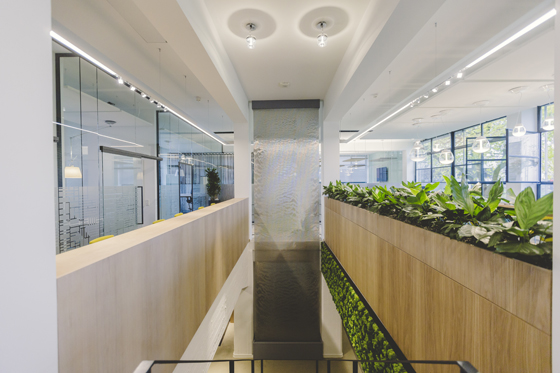
In addition to offering a sweeping view of the countryside, generous windows complement various indoor features, such as a water wall and plants which improve the office atmosphere. Photos: Lichthalle Krefeld
×Built by Holthoff around 1935, the gatehouse, today called the ‘Speditionshaus’, occupies the entrance to the site, making it a prominent address. The flat-roofed building, with its expansive windows and simple, cubic form, draws strongly from the HE Building and has a similarly open structure. This was a great advantage in the realisation of the biophilic design-based interior: “We decided on a design concept that respects the clarity and structure of the former gatehouse, yet also reflects the corporate DNA of Interface, in that it interrupts the orthogonal grid of the open floor plan in defined areas with biophilic elements and organically formed functional units,” says Anne Salditt, Interface Marketing Director for Central Europe.
Biophilic design is based on the theory that, both physically and mentally, human beings feel more comfortable in nature, which has greater rejuvenating effects on us. But because our evolution has led to our spending most of our time in enclosed spaces, it is necessary that we re-establish a stronger connection with nature. In the work environment, especially, this is seen as a path to heightening concentration and productive capacity and improving health.
Encompassing 650 square metres, the new German headquarters offers open as well as private work and meeting areas – not to mention a showroom. Photos: Bernadette Grimmenstein
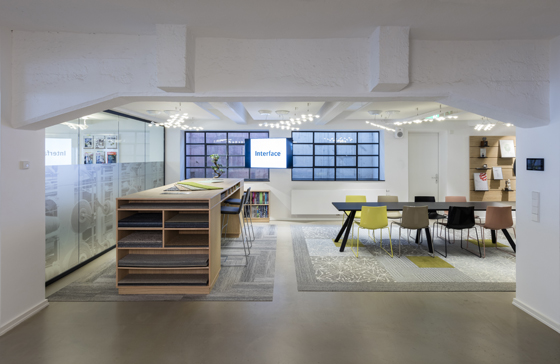
Encompassing 650 square metres, the new German headquarters offers open as well as private work and meeting areas – not to mention a showroom. Photos: Bernadette Grimmenstein
×At Interface’s new German headquarters, this is happening in various ways. For example, nature is brought into the interior space through the integration of natural materials and elements: a wall of stone and plants and a water wall that connects the ground and basement floors enhance the indoor climate. The carpet tile collections Equal Measure, Composure and Human Nature also play an important role, with colours, patterns and textures that recall pebbles, sand and grass.
Additionally, the ceiling-high windows with their elegant, understated steel frames offer generous views into the surrounding trees. This quality is accommodated by the glass partition walls and flowing interior spatial transitions, which allow the unrestricted entry of daylight. The open interior design concept without permanently assigned workstations reflects the company’s approach to creating a workplace that is adapted to the needs of the individual.
A staircase joins the ground-floor and basement, and should you find yourself in need of more exercise, directly across are further opportunities for sport. Photo: Bernadette Grimmenstein
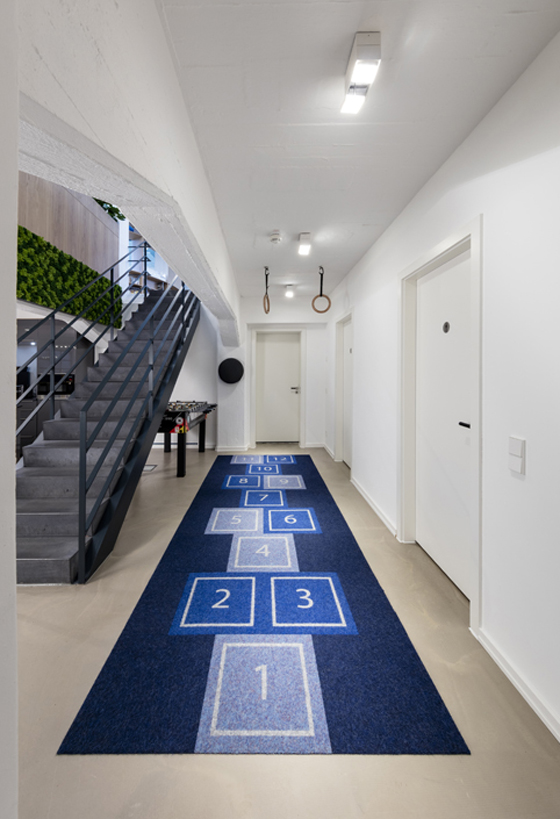
A staircase joins the ground-floor and basement, and should you find yourself in need of more exercise, directly across are further opportunities for sport. Photo: Bernadette Grimmenstein
דAs a company, we are intensively concerned with how the work environment influences people’s well-being,” explains Anne Salditt. “In the gatehouse we have found a place that is superbly suited to us and in which we can strikingly demonstrate our expertise to our customers and partners, as well as to our own team.” The new German headquarters thus not only unites in this distinguished building open and private areas for meetings, group work or quiet, focused tasks, but at the same time serves as a showroom for biophilic design – a place in which visitors can experience its effects “out in the wild”.
During the renovation, the building was gutted and subdivided using glass walls. Photo: Lichthalle Krefeld
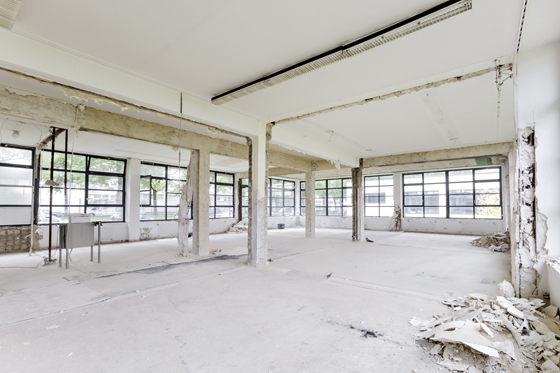
During the renovation, the building was gutted and subdivided using glass walls. Photo: Lichthalle Krefeld
ש Architonic





